A look at T-Comm, the Transit Communications centre
A look at T-Comm, the Transit Communications centre
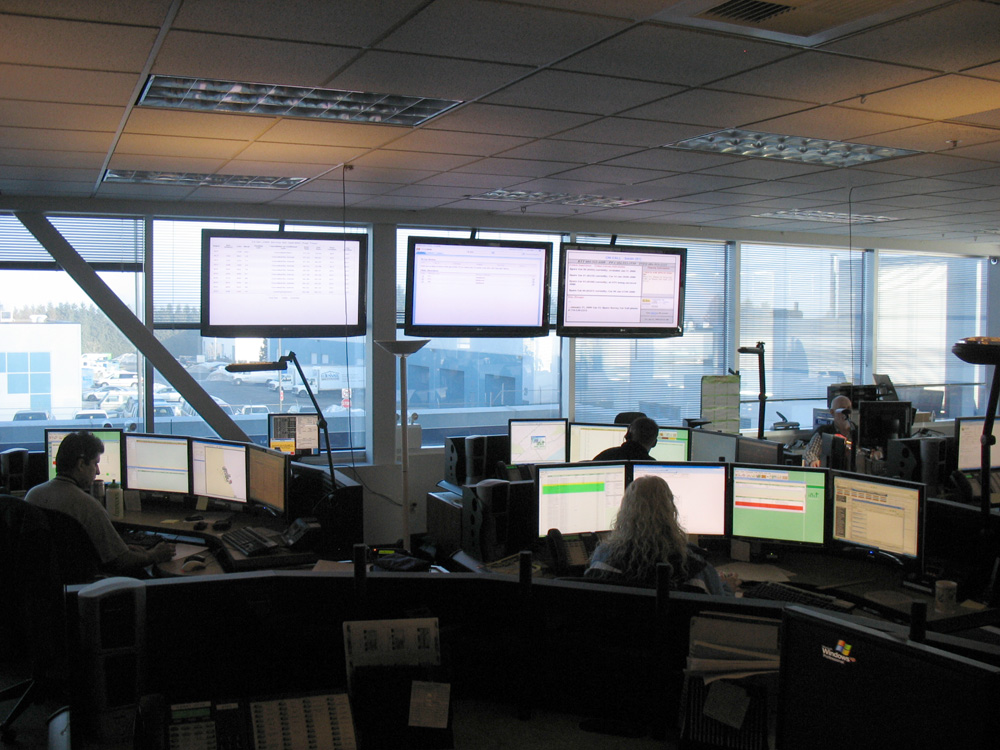
When a transit operator talks on their radio, have you ever wondered who’s answering at the other end?
It’s the men and women working at Transit Communications, which is located out at the Surrey Transit Centre.
T-Comm, as it’s often called, is like an air traffic control centre, but for public transit instead. Twenty-four hours a day, three to seven T-Comm supervisors are constantly monitoring the buses on the system. They manage the flow of bus traffic as much as possible, and provide information and support to operators as needed.
I was lucky enough to visit T-Comm, meet the fine folks who work there, and see their brand-new real-time communications system in action. So, let’s take a closer look and see what managing a bus system is all about!
The T-Comm centre
Just thought I’d do a video of the T-Comm centre for you, to better show what the room looks like. I’m standing at the back of the room here.
David Doney, one of the duty managers at T-Comm, gave the tour and pointed what everyone in the room is doing. The three desks at the front are devoted specifically to managing buses in the City of Vancouver. The two on the back left are managing Port Coquitlam, North Vancouver, & Burnaby. The two on the back right are for Richmond and Surrey.
Every day, T-Comm receives 1,000 calls from operators a day – on a busy day, that number can double. Seven supervisors staff all the desks during the peak hours, and late at night (10 p.m. to 6 a.m.), four staff man the posts. The average response time for non-emergency calls is three minutes, and David says they’re even working on taking that down to 90 seconds.
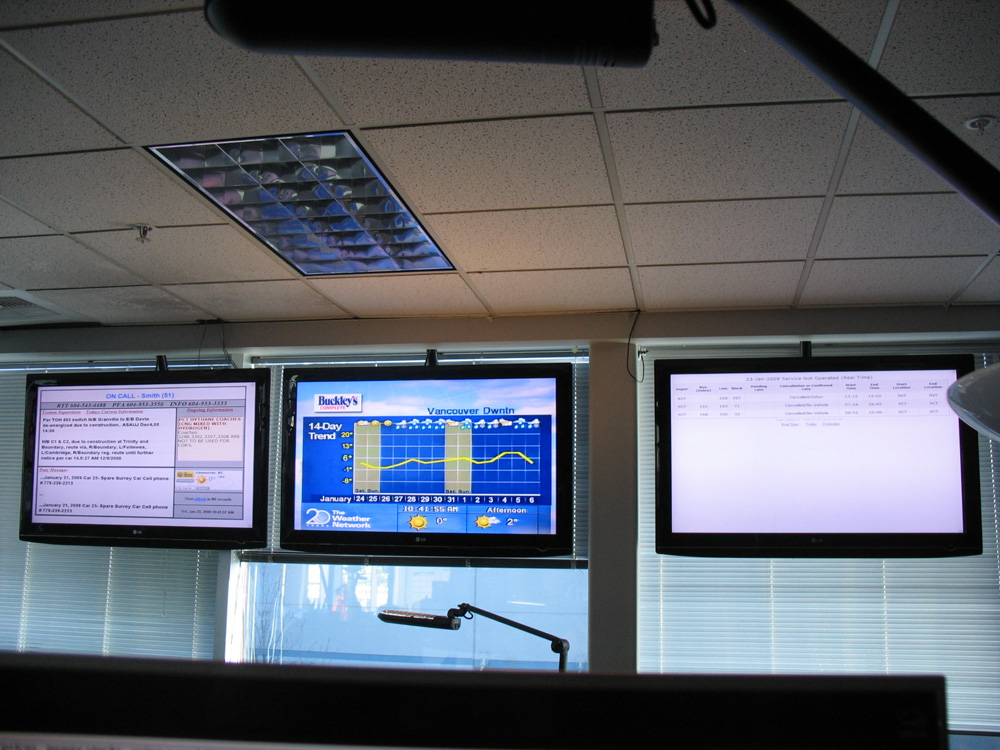
Also, along two different walls in T-Comm, three screens hang from the ceiling to give everybody access to crucial information.
The leftmost screen holds key updates about the system, inputted by T-Comm supervisors.
The centre screen is tuned to television stations that might be transmitting important information – it’s currently on the weather channel right now. And the rightmost screen shows any known bus cancellations and the reasons why.
The new communications system
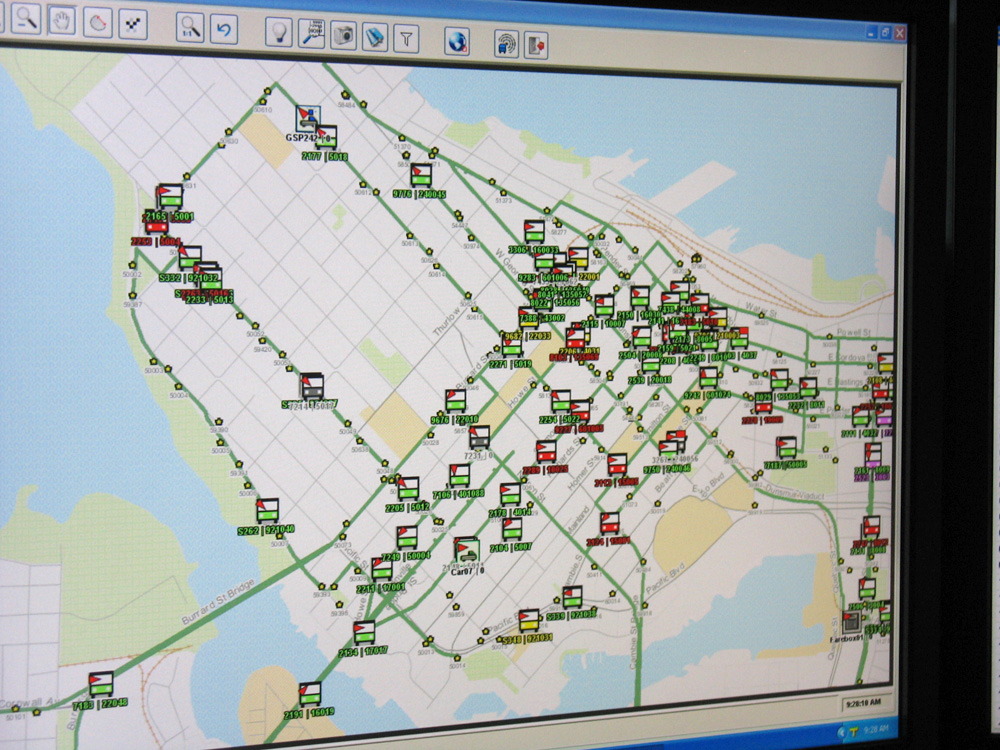
The screen above might look like a videogame, but it’s actually a real-time look at the bus traffic in downtown Vancouver. (It’s not this morning’s traffic – this photo was taken a few weeks ago, sorry!)
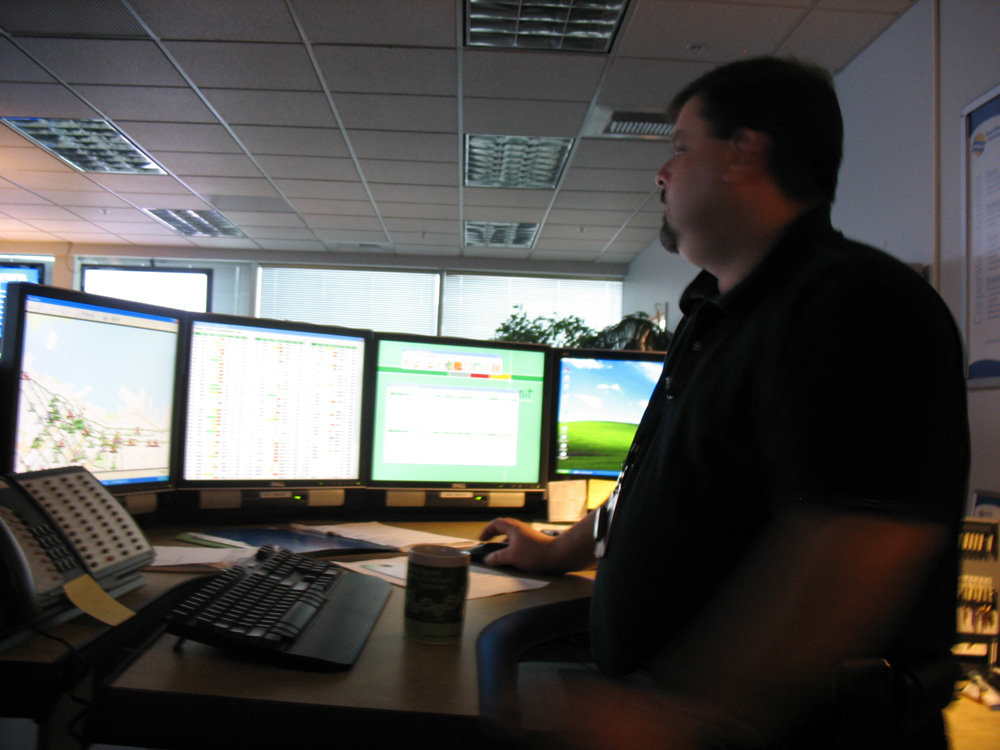
Real-time region maps and data are what T-Comm supervisors now monitor, thanks to the brand-new, highly sophisticated Transit Management and Communications System (TMAC), which completed installation at the end of 2008.
The new system supplies real-time data about every bus and support vehicle in the fleet, through Global Positioning System (GPS) technology. The buses now constantly send signals to the system, identifying their location and their status – opening doors, passing a stop, etc. Obviously, this opens up some really powerful ways to manage and monitor the system.
Maps like the one above are just one example of the useful information now available to T-Comm supervisors. Since the data displays in real time, the map updates every two minutes, and you can track the buses as they follow their routes.
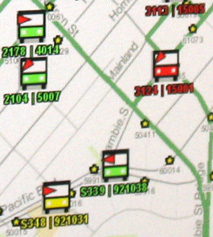
The eagle eyes among you can probably see that all the buses have different colour codes, too. The codes show which buses are ahead or behind schedule. Here’s the key:
- Red – ahead of schedule by 30 seconds or more
- Green – On Time (this is where we want buses to be!)
- Yellow – Less than 5 minutes behind schedule
- Purple – Less than 10 behind schedule
- Blue – More than 15 minutes behind schedule
(As you can see, most buses are green, so they were doing quite well that morning!)
If any bus reports that they need help, supervisors can also get the system to immediately show the location of support vehicles in the vicinity. A supervisor could then alert the right support vehicle and send them over to help.
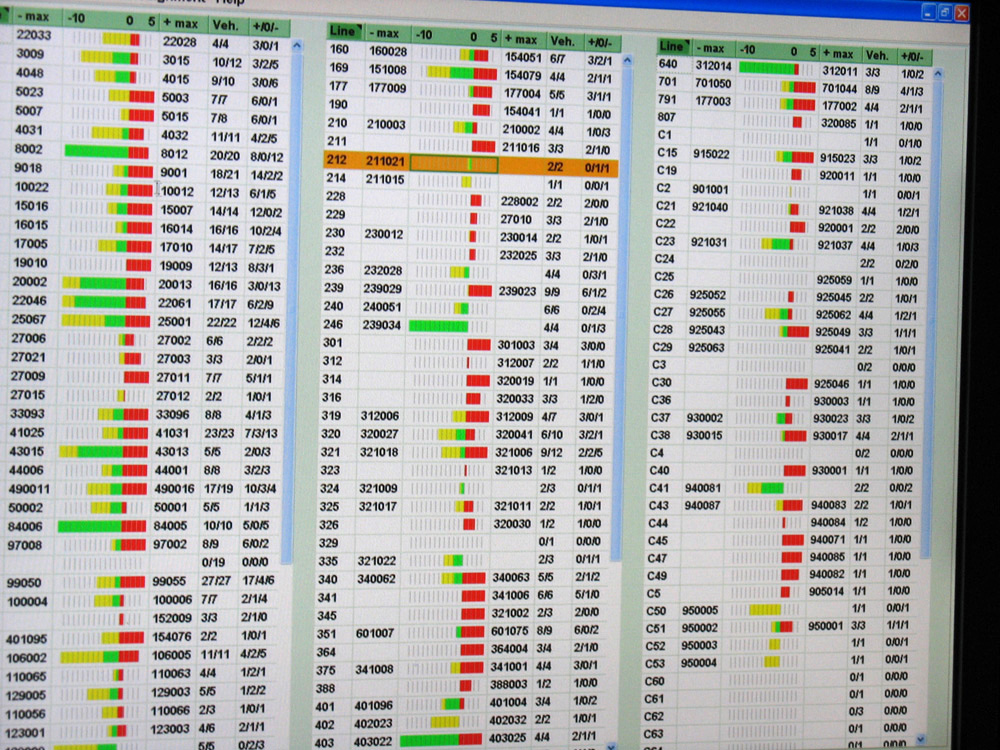
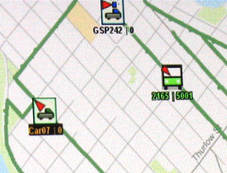
You can see that on the image to the right—we selected bus 2165 as the target bus, and the support vehicles nearby were immediately shown.
More data is also available in non-map form: for instance, in the image at the far right, the stats for all the lines are updated in real-time.
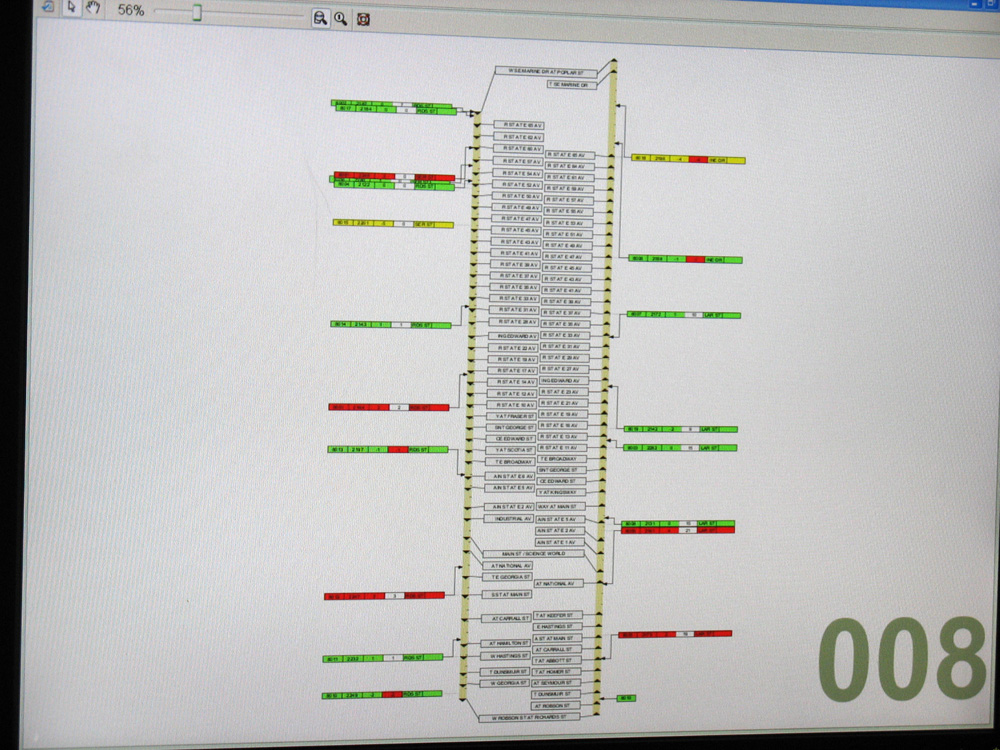
Each line shows a bus route, and the colour codes indicate how ahead or behind schedule it is. The system also tracks exactly which bus is furthest ahead and which is furthest behind, and how many vehicles are on the route.
You can also drill down further and see even more detail about the individual routes, like the #8 route at right. This screen shows all the buses on the route, exactly where they are located, if they are ahead or behind schedule, and more.
Better communication with operators
The new TMAC system also helps T-Comm better communicate with operators.
First, the system installation at the end of 2008 included a full upgrade of our radio system. Digital radios were installed in all the buses, and we put up our own radio towers, meaning we don’t have to rely on third-parties to transmit our communications anymore. ( Correction: In fact we have never relied on third parties to transmit our communications. Transit Communications leases space on existing towers for our radio antennas and microwave dishes, as do most radio systems like police, fire, and ambulance radio systems. In the past we did however rely on leased phones lines to connect the radio sites with the communications centre. The major difference in our new system is the backhaul (the way the data flows between the radio sites and the communications centre). For TMAC we built our own microwave system (instead of continuing to depend on leased phone lines) so we can directly control the data flow.)
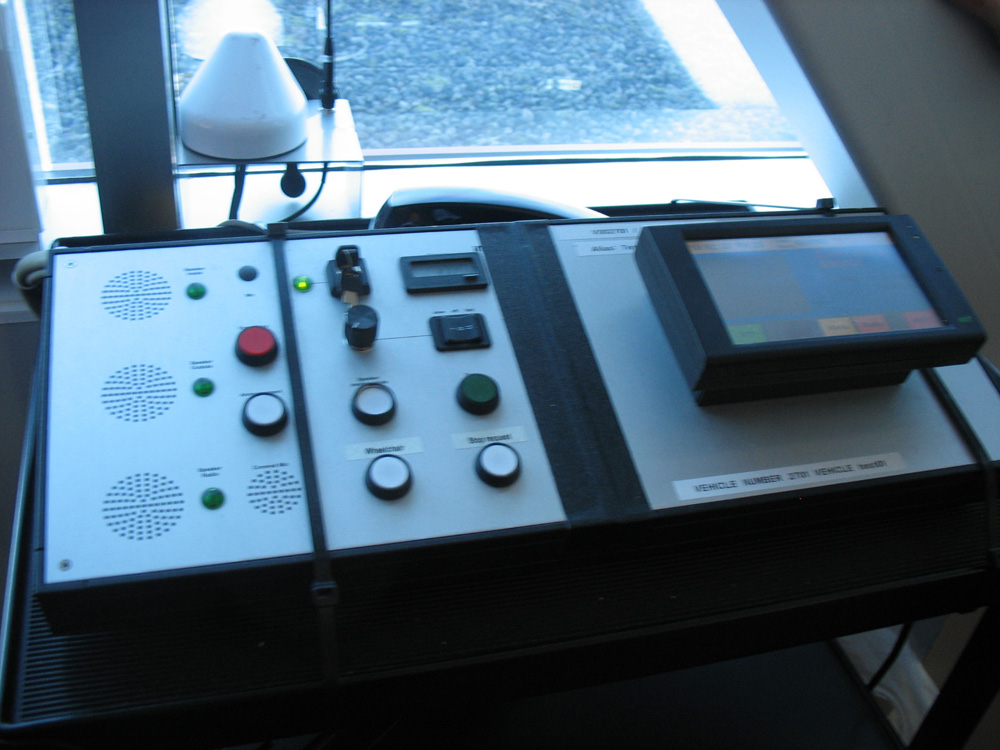
What does the communications panel look like inside the buses? At right you can see the panel that operators use. (It’s a test box used for training, which is why it’s just sitting on a ledge).
A red emergency button is at the left of the panel. If an operator is being assaulted, he or she can hit the red button, and T-Comm will be alerted. The radio will automatically kick in and T-Comm can listen in for 30 seconds to hear what is happening, while they work to send assistance. T-Comm can actually listen in for continuous bursts of 30 seconds—the radio stops sending voice for a moment, transmits location and other data, and then returns to the monitor (listen in). This monitoring can continue indefinitely at TComm’s discretion.
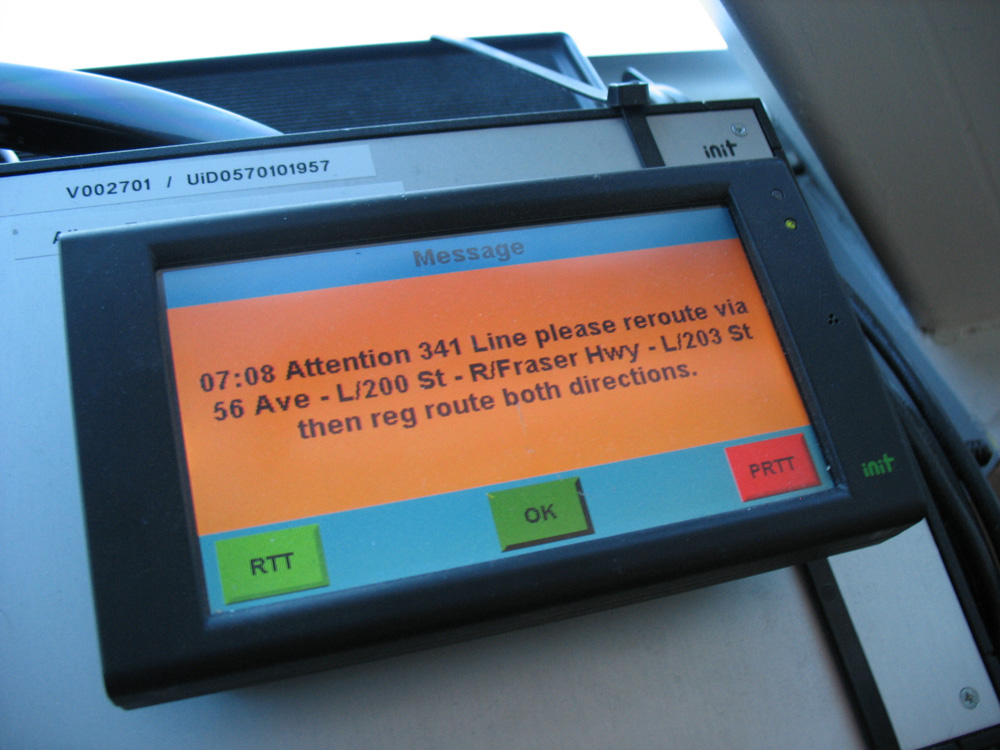
Also of note is the screen on the side. T-Comm can deliver text messages straight to the screen, making it easy to communicate with operators without picking up the radio.
The screen also efficiently informs drivers of any reroutes at the start of their shift. T-Comm supervisors can input a reroute into the system – say, a reroute for bus #10, #16, and #17. Then TMAC is smart enough to only alert drivers on routes #10, #16, and #17 of the reroute via the screen, alerting them after they sign into the system.
New vs. old systems
The new system is a vast improvement over our old transit communications—a hodgepodge of four separate systems, including an original Motorola radio system and a system of cell phones given to drivers.
And while it’s still early in the launch of the system, so T-Comm and our operators are continuing to learn more and more about TMAC’s capabilities and how to use them to better manage our fleet.
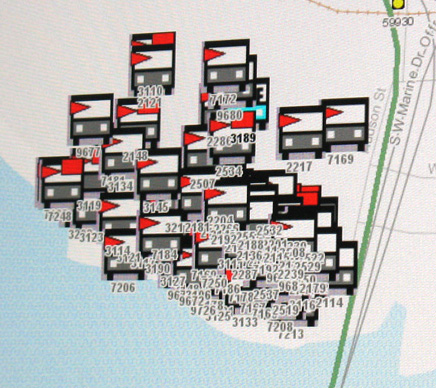
But we do know right now the real-time data and better communications help T-Comm be more proactive in managing the fleet. They’re now able to notice late buses and take care of them before they become a problem. And over time, the collected data will help us better notice traffic issues and respond accordingly.
As well, TMAC is well able to handle our vehicle fleet and the anticipated expansions expected for the future.
I’ll leave you with a fun picture of what the Vancouver Transit Centre looks like on the real time map. If you have any questions, feel free to send them along in the comments!






This is still really interesting with the new TMAC system on how it can see everything the operator is doing. The time issue can be key and can be stressful on many issues. But my questions why is the response from T-Comm to the driver still over 10 min. Or even the call dropped, or board “Cleared” That needs work but then again there are operators i have noticed as a passenger that many “Junior operators” are refusing to log in to the TMAC system and follow the rules set by the company. And can someone at CMBC strictly enforce a ban of cellphone’s and iPod with earbuds in the ear. This is becoming such a big problem that they are not putting safety as number 1. A call to customer relations will not do as it keeps happening. That is my rant as i would like to see the bus system as safe as possible. Have a good afternoon.
Dan
Thanks for sharing this, Jennifer! It would be great for transit users to have access to this kind of information. Imagine knowing where your bus was, wow! (or is there already some way for me to see where my bus is that I don’t know about?)
Great article. Thanks Jhenifer for posting this. I really enjoy the behind the scenes blogs.
I’d like to see a “day in the life” on SeaBus from maintenance to running, etc. Skytrain and west Coast Express too.
Also, some more tours of Canada Lien would be nice.
Dan – are you sure those areIpods they’re listening too. Many operators use custom ear plugs to reduce noise – they don’t completely block it, just reduce it. As you can imagine, a bus is a noisy work environment and drivers need to take care of their hearing.
Yeah, why can’t we get a real time map online? Seattle’s had something like that since at least 2002: busview.org
Hey Holly and Alan,
So I asked T-Comm your question about real-time map availability for customers. Essentially, TMAC is a proprietary system and there are licensing constraints — which means only the supervisors in T-Comm have access to the TMAC data in those forms displayed in this article.
Not that we don’t want to get real-time data out to customers — just that we can’t just give you the TMAC system and its displays wholesale. But we can still derive useful products from the data generated by TMAC. I do know that there is a project working to get customers real-time next-bus info is very tentatively due to complete in fall 2009. Just be aware that TMAC generates a HUGE amount of data and translating it into a useful customer interface takes a lot of work.
Thanks for the tour Jhenifer, I’d also like to see more.
I’m sure many tech junkies, the kind most likely to frequent your blog, would love a real time map. In fact some would probably spend a fair bit of time just watching the little icons moving around the map, but I don’t think the general public wants that because it forces them to guess what’s likely to happen between now and when the bus reaches their stop.
I think the public wants to know three things:
– how long will I have to wait for my bus
– how crowded will that bus be
– will I make or miss my upcoming transfers
The first one needs to take the real time data and add a predictive component based on factors not already accounted for in the schedule like unusual traffic conditions, the actual time taken by the buses ahead of it to cover that segment, and whether or not that particular bus will meet any connecting buses along the way. It’s complicated, but can be done with reasonable accuracy 19 times out of 20.
Telling prospective passengers whether they’re destined for a seat or a smelly armpit isn’t all that difficult either. I’d put sensors on the suspension system to detect the passenger load. It’d miss things like strollers and small children taking up space, but those passengers usually travel at predictable times of day so the system would be right most of the time.
Predicting whether or not you’ll make a connection 30 minutes into the future is something customers really want to know, but it’s so complicated that CMBC probably doesn’t want to attempt it.
I’m not sure if I missed it in the text but what do the flags mean on the bus icons?
Bill, I’m guessing those little red flags are pointers to show which direction the bus is travelling.
Great post! I was actually wondering why the LED displays at skytrain stations do not display any up-to-date information other than the line and Elevator closures and escalator closures, etc. It would be nice to have: next train in __min.; line name; but also if the system is down a realtime response on them. (Like, System Delayed Police Incident at _____ please use alternate service, etc.)
Just would like to know because I was in London and most tube displays were like this.
Thanks for sharing this with us, Jhenifer. I appreciate seeing how much effort goes into our system.
Great article! Can’t wait to read one about the SkyTrain control centre :P
Very interesting article…it would be interesting to see how SkyTrain control works too!
Bill & Thomas: yes, the flags indicate the direction the buses are driving in.
Dennis & Jeff: don’t you worry, the SkyTrain control story will be coming soon :)
Hi Brandon,
I’ve asked SkyTrain about your question and here’s what I’ve got for you.
The existing PLEDS (Platform Light Emitting Diode Sign) are primarily designed to inform passengers regarding train destinations and it is configured to our Train Control System. A system upgrade would be necessary to override the existing program.
The trains are already running as frequently as every 108 seconds during rush hours between Columbia and Waterfront station so passengers don’t really need the next arrival time during that period. As well, when there are service disruptions, it is difficult to determine instantly when normal service will resume. SkyTrain Control Operators will have to determine the extent of the problem, evaluate the situation, analyze and identify the source of the problem prior to making definite announcements of service restart. Our Control Operators will make onboard announcements or station announcements when we have service disruptions.
The existing PLEDS (especially on the Expo Line) will need to be replaced at some time in the future but there are no capital project commitments at this time. Meanwhile, we are installing digital signage at five station entrances so customers will know before they enter the station that there are operational issues or emergencies in progress. This project will be completed by the end of March and we hope to expand this to more stations as budget permits.
[…] is in contact with its staff on the ground, they can also supply real-time bus information from TMAC, its internal tracking system. SkyTrain can also do the […]
[…] (If you don’t know, T-Comm is our Transit Communications Centre out in Surrey, which monitors and coordinates our entire bus system. It’s kind of like air traffic control for buses! Here’s a past blog post explaining the T-Comm centre and how they do what they do.) […]
[…] supplied the GPS-based communications and announcement system on our bus fleet (read more about it here). Also, if you stepped through the entrance, Init’s automatic passenger counter would count […]
i always order wholesale jeans from online wholesale shop.
[…] also have time to troubleshoot customer issues in real-time, and they can access the real-time bus tracking system to help them out. It’s been pretty amazing to see the Customer Information staff look up […]
[…] […]
[…] visit to T-Comm, the control centre where we manage our bus […]
[…] the Buzzer blog’s founding editor, and so proud I shared stories from the Olympics, from our control centres and garages, from transit conferences near and far, through podcasts, video, and more. And […]